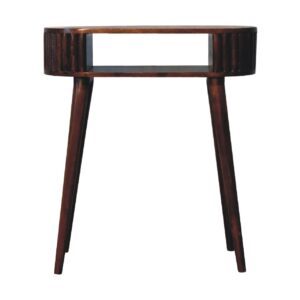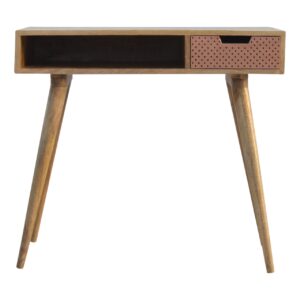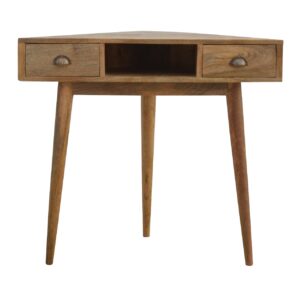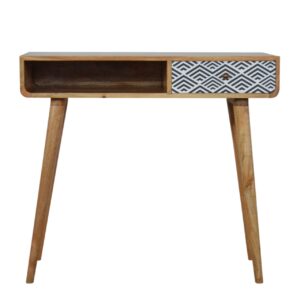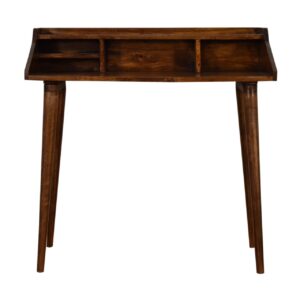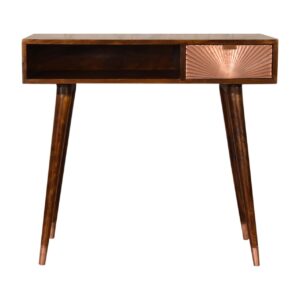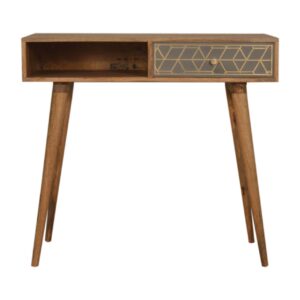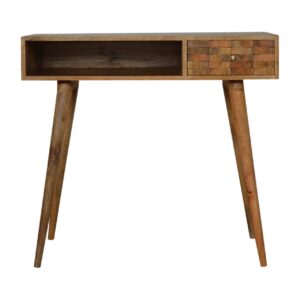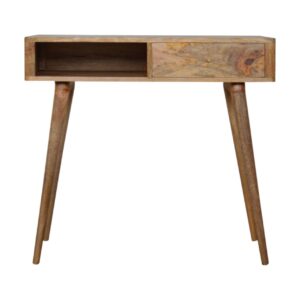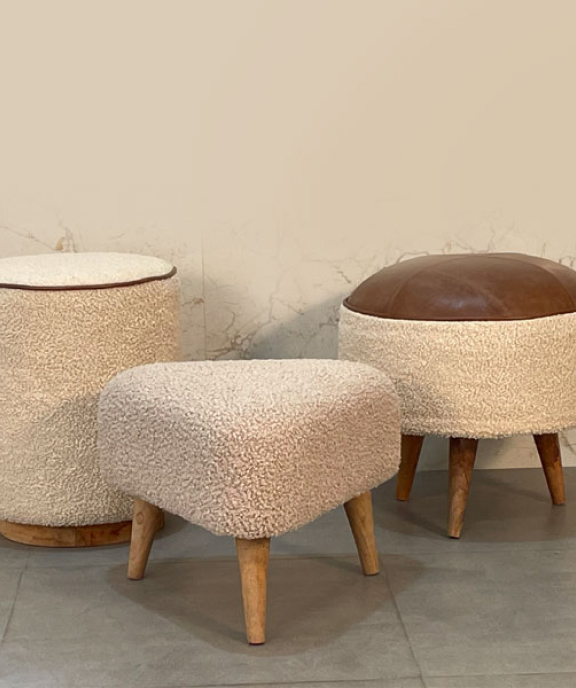The study of antique writing desks offers a window into the aesthetic and functional concerns of past societies. Often seen as a reflection of the cultural zeitgeist, these desks have evolved through various historical periods, each style telling its own story about the artisanship and ergonomics of its time.
From the utilitarian forms of the earliest desks to the ornate designs of the Baroque and Rococo periods, and then to the restrained elegance of Neoclassical pieces, these objects of study provide insight into the evolution of furniture design. This examination not only chronicles the metamorphosis in style but also encapsulates the broader artistic movements and the shifting priorities of functionality and form.
In preserving these relics, historians and enthusiasts alike are able to trace the lineage of craftsmanship and aesthetic sensibilities through the ages.
Origins and Early Forms
The origins of antique writing desks can be traced back to the late 17th century, with early forms often featuring elaborate marquetry and constructed as status symbols for the affluent. In examining the desk evolution, one observes a marked transition from communal writing spaces in scriptoria to the privacy of individual writing furniture.
The scriptorium origins, typically associated with medieval monasteries, were the predecessors to the personal desk, emphasizing a collective environment for copying manuscripts.
As literacy spread and the need for personal, at-home writing spaces increased, the desk evolved into a more intricate and personal item. Early desks were masterpieces of craftsmanship, replete with intricate inlays and veneers, signifying not just utility but also the wealth and education of their owners.
The transformation from the scriptorium’s austere functionality to the ornate domestic writing desk of the 17th century encapsulates a broader cultural shift towards individualism and the valorization of private study and correspondence. The transition underscores a significant development in furniture design, reflecting societal changes in literacy, the dissemination of knowledge, and the growing value of personal, reflective space for intellectual pursuits.
The Renaissance Influence
Influences from the Renaissance period significantly reshaped the design and functionality of antique writing desks, reflecting the era’s renewed interest in classical learning and fine arts. The transmutation of such furniture from mere utilitarian objects to symbols of scholarly and aesthetic prestige is evident in the material selection and the application of craftsmanship techniques during this time.
Renaissance artisans selected woods like walnut and oak for their robust qualities and sumptuous appearance, which not only provided durability but also allowed for intricate carvings and marquetry. The veneer technique was perfected to create surfaces that showcased the natural beauty of wood grain in an artistic manner. Furthermore, the use of metals and inlays became more prominent, with craftsmen incorporating materials such as ivory, gold, and brass for ornamentation.
The craftsmanship techniques evolved to include elaborate joinery and sophisticated mechanisms. Dovetail joints, which were both strong and aesthetically pleasing, became commonplace. Desks featured innovative designs such as the ‘bureau-cylinder’ and ‘bureau-Mazarin’, which offered a combination of writing surfaces, secret compartments, and drawers. These advancements signified a departure from the simplistic forms of earlier periods, emphasizing the Renaissance’s reverence for artistry and intellectualism in every aspect of life, including the construction of writing desks.
Baroque and Rococo Variations
Transitioning into the Baroque period, antique writing desks displayed a marked evolution with their ornate curves and elaborate ornamentation, epitomizing the grandeur and dynamism of the era. The Baroque style, which originated in early 17th century Italy and spread across Europe, was characterized by its emphasis on bold, dramatic forms and intricate details. These desks often featured ornate carvings, which were not merely decorative but also a testament to the craftsmanship and artistic prowess of the period.
The desks of this period were frequently adorned with gilded edges, adding a layer of opulence and reflecting the societal shift towards ostentation. Scholars have observed that the gilding process, which involved applying thin layers of gold leaf, was not only a symbol of wealth but also an indication of the owner’s status and taste. The intricate carvings and gilded accents were more than mere embellishments; they served to convey the cultural and philosophical ideals of the Baroque movement—namely, the power, triumph, and emotionality that were central to its aesthetic.
As the Baroque period gave way to the Rococo in the 18th century, writing desks evolved yet again, exhibiting lighter forms and more playful themes, often incorporating asymmetrical designs and a more whimsical approach to ornamentation.
The Neoclassical Wave
While the Rococo period indulged in playful extravagance, the Neoclassical wave, emerging in the late 18th century, marked a return to restraint and symmetry, profoundly influencing the design of antique writing desks with its emphasis on simplicity and classical Greco-Roman aesthetics. This period, characterized by the Greek Revival, saw furniture designers drawing inspiration from the ancient civilizations of Greece and Rome, echoing the architectural symmetry that was central to those cultures.
The antique writing desks of the Neoclassical era were thus emblematic of this Greek Revival, incorporating fluted legs, linear forms, and often featuring lyre-shaped supports or pilasters with carved capitals reminiscent of ancient columns. Inlays and marquetry were employed with sophistication, depicting motifs such as urns, laurels, and acanthus leaves, albeit with a restraint previously unseen in furniture design. The veneers used were typically of mahogany or satinwood, valued for their rich, natural hues and ability to be polished to a subtle sheen that complemented the understated elegance of the Neoclassical style.
Preserving Antique Writing Desks
Preservation of these antique writing desks is essential to maintaining the cultural and historical integrity that they represent. Desk restoration, when approached with meticulous care and scholarly rigor, serves not merely as a means of aesthetic rejuvenation but as a method of wood conservation. Each desk, a silent narrative of the era it originates from, demands a nuanced understanding of its material composition, craftsmanship techniques, and historical context.
The process of wood conservation encompasses both the stabilization of the desk’s structure and the preservation of its surface patina, which often bears the hallmark of time. Specialists in restoration must employ analytical strategies to discern the original materials used, such as specific wood species, veneers, and finishes. This knowledge informs the selection of compatible materials for repairs, ensuring that the desk’s authenticity is not compromised.
Inherent in the scholarly approach to preservation is the detailed documentation of the desk’s condition prior to and following restoration efforts. Such records contribute to the collective knowledge base surrounding antique writing desks, facilitating future research and preservation endeavors. The objective, ultimately, is to extend the life and historical narrative of these desks, allowing them to endure as tangible connections to our past.
Frequently Asked Questions
How Can I Accurately Determine the Market Value of My Antique Writing Desk?
To accurately determine the market value of an antique writing desk, conduct a thorough condition assessment and analyze current market trends, considering factors such as rarity, provenance, and demand within the antiques market.
Are There Any Modern Manufacturers That Create Authentic Reproductions of Historical Writing Desk Styles?
Several modern manufacturers employ advanced reproduction techniques and craftsmanship to create authentic reproductions of historical writing desk styles, catering to a niche market of enthusiasts seeking period-accurate furniture pieces.
What Are the Ethical Considerations When Restoring an Antique Writing Desk That May Have Cultural Significance?
When restoring culturally significant antique writing desks, ethical considerations include respecting the artifact’s integrity, ensuring cultural preservation, and involving stakeholders to maintain the desk’s historical and societal value through careful and informed restoration practices.
How Can I Distinguish Between an Original Antique Writing Desk and a Well-Made Replica?
To distinguish an original antique writing desk from a replica, examine the desk’s patina and construction techniques, focusing on signs of age, craftsmanship authenticity, and materials consistent with the period of the original design.
What Impact Does Provenance Have on the Collectibility and Value of an Antique Writing Desk?
Provenance significantly enhances a desk’s authenticity, offering verifiable history that increases collectibility and intrinsic value. Meticulous provenance research can affirm originality, thereby impacting the desk’s monetary and historical worth to collectors.


